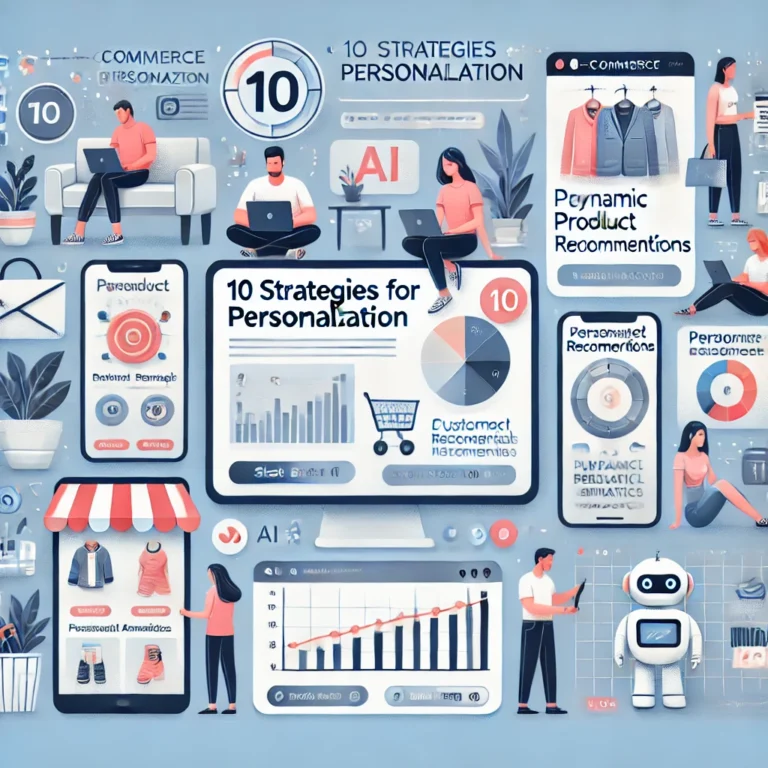In todays world customers face a flood of online shopping encounters. Picture stepping into a shop where a warm welcoming salesperson recalls your tastes recommends items you’d truly adore and streamlines the process. This exemplifies the impact of tailored ecommerce shopping experiences. By customising your online store to cater to customer preferences and desires you can convert the shopping journey from vexing to smooth sailing nurturing loyalty and boosting sales. This piece will provide you with the insights and tactics needed to create ecommerce experiences that encourage repeat business.
Consider this; Wouldn’t you prefer to shop at a store that remembers your tastes suggests items you’d genuinely enjoy and makes the whole process effortless? That’s the enchantment of personalization – it’s not just a passing trend; it represents the future of commerce.
I understand if you’re pondering; “Personalised experiences sound appealing but how do I get started?” Fear not; I’m here to lead you through each step of the process, with real life examples to ignite your imagination.
Why Personalised Ecommerce Experiences Matter
Picture yourself stepping into a brick and mortar store where a welcoming sales associate addresses you, by your name recalls your brands. Recommends a fresh jacket that beautifully matches your current wardrobe. This exemplifies the impact of service.
In the digital world, it translates to:
- Increased customer satisfaction: Studies by McKinsey & Company show that personalisation can lead to a 10% uplift in customer satisfaction. When customers feel valued and understood, they’re more likely to have a positive shopping experience and come back for more.
- Boosted sales and conversions: Research by Statista suggests that personalised product recommendations can increase conversion rates by up to 70%. By showing customers exactly what they’re interested in, you remove friction from the buying journey and make it easier for them to convert.
- Enhanced customer loyalty: Remember that salesperson who remembered your preferences? They built a relationship with you, right? Personalised experiences do the same thing online. By catering to individual needs and preferences, you foster customer loyalty and encourage repeat business.
The takeaway? Tailored online shopping experiences are not merely a luxury – they are essential, for business success.
Crafting Personalised Ecommerce Shopping Experiences for Your Customers
Now that we’ve clarified the reasoning, behind it lets explore the methods. Here are some practical approaches to customize your online shopping experience;
- Embrace customer segmentation: Customers vary in their preferences and behaviours. By categorising your audience according to factors, like age buying patterns, online activity and interests you can personalise your communication and product suggestions, for each segment.
An activewear shop for instance could divide its customers based on their fitness objectives (such, as runners, weightlifters and yogis). Then present them with products and inspiring content tailored to each segment.
- Leverage the power of product recommendations: Gone are the days of generic “You might also like” suggestions. Utilise customer data to recommend products that genuinely complement past purchases or past and in session browsing behaviour.
Think about Amazon’s recommendation engine – it’s a masterclass in personalisation. By understanding your past purchases and browsing habits, it suggests items you’re likely to be interested in, keeping you engaged and upping the chances of a sale.
- Personalise your marketing efforts: Gone are the days of blasting generic emails to your entire customer base. Segment your email list and tailor your messaging to each group.
Gone are the days of blasting generic emails to your entire customer base. Segment your email list and tailor your messaging to each group.
- Get creative with dynamic content: Swap out generic website content with dynamic content that adapts to each individual visitor. This could include showcasing products from a customer’s preferred brand or highlighting recently viewed items.
Imagine a beauty website that displays a personalised homepage banner featuring the customer’s favourite foundation shade alongside new lipstick colours in their preferred brand.
- Don’t forget the power of retargeting: Retargeting allows you to show targeted ads to website visitors who haven’t converted yet. This is a powerful way to remind them of products they viewed and potentially nudge them towards a purchase.
For example, a customer who browsed a specific pair of running shoes on your website could see retargeting ads featuring those same shoes on other websites they visit.
Don’t forget; Personalisation doesn’t need to be complicated. Begin with steps try out one or two tactics, track the outcomes and make adjustments as needed.
The Power of Personalised Ecommerce Shopping Experiences in Boosting Sales
Let’s bring these personalisation strategies to life with some inspiring examples from from players in the industry:
- Boots UK: This footwear retailer uses a combination of customer segmentation and dynamic content. They segment their audience by demographics and interests, then showcase personalised product recommendations and inspirational content on their website. A customer interested in men’s workwear will see a different homepage experience compared to someone browsing women’s hiking boots.
- Spotify: The music streaming giant is a master of personalisation. They leverage listening history and preferences to curate personalised playlists like “Discover Weekly” and “Release Radar.” This keeps users engaged and exposes them to new music they’re likely to enjoy.
- Netflix: Similar to Spotify, Netflix utilises user data to recommend movies and TV shows tailored to individual preferences. Their recommendation engine analyses viewing history and identifies patterns to suggest content users are likely to enjoy. This keeps viewers engaged and reduces subscription churn.
Delivering Personalised Ecommerce Shopping Experiences with AI
Artificial intelligence (AI) is revolutionising the world of personalised ecommerce experiences. Here’s how:
- AI-powered recommendations: AI algorithms can analyse vast amounts of customer data, including purchase history, browsing behaviour, and demographics. They then use this data to recommend products with an uncanny level of accuracy.
This goes beyond simply suggesting similar items. AI can identify underlying patterns and connections that humans might miss, recommending complementary products or those catering to specific needs or preferences.
- AI-driven chatbots: Say goodbye to frustrating FAQ sections. AI-powered chatbots can provide real-time customer support, answer questions, and even offer personalised product recommendations based on a customer’s conversation history.
A scenario where a customer engages with a chatbot to ask about a product involves the AI providing information on the product offering suggestions, for items or recommending accessories that pair well with the selected item.
- Predictive analytics: AI has the capacity to review information and recognise patterns in order to forecast customer actions. This enables you to customise marketing strategies and suggest products, in advance to meet customer demands even before they emerge.
For instance an AI system could anticipate that a customer who has just bought a laptop may have an interest, in a carrying case or wireless mouse. This enables you to send personalized emails or show pertinent product suggestions, on the site even before the customer begins searching.
Keep in mind; AI is a resource. It must be employed ethically and conscientiously. Always put customer privacy first. Ensure transparency regarding the utilisation of their data.
Navigating the Dynamics of Customer Preferences
Understanding personalisation goes beyond displaying products at the most opportune moments. It involves delving into the psychology that influences customer choices. Here’s what you should be aware of;
- The Evolution of Customer Preferences: Today’s customers expect a more personal touch. They’re bombarded with generic marketing messages everywhere they turn, and they crave genuine connections with brands. This means offering experiences that feel tailored to their individual needs and preferences.
- The Psychology Behind Personalised Ecommerce: People are more likely to trust and engage with brands that “get” them. Personalisation taps into this desire for connection. When customers see products and content relevant to their interests, it makes them feel valued and understood. This emotional connection translates into increased trust, loyalty, and ultimately, sales.
- Understanding the “Why” Behind Personalisation: Customers seek personalised experiences for several reasons:
- Convenience: They don’t want to waste time sifting through irrelevant products. Personalised recommendations streamline the shopping journey and help them find what they need quickly.
- Discovery: Personalisation can expose them to new products they might not have considered otherwise, leading to exciting discoveries and potential purchases.
- Validation: Seeing products and content that resonate with their interests makes them feel understood and validated.
To truly grasp these motivations you have the opportunity to create tailored experiences that address both the emotional requirements of your customers.
Using Personalisation Tools for Enhanced Engagement
Now that we understand the “why” behind personalisation, let’s explore the “how” with some key tools:
- Harnessing Data Analytics for Personalisation: Data is the lifeblood of personalisation. Use analytics tools to track customer behaviour, analyse purchase history, and understand browsing habits. This wealth of information allows you to segment your audience and tailor your marketing efforts accordingly.
For instance you might examine the data, on website visits to pinpoint which types of products certain demographic groups are particularly drawn to. This helps tailor your marketing efforts and suggestions, for products to suit these segments.
- Implementing AI-driven Recommendations: AI algorithms can analyse vast amounts of customer data to generate highly accurate product recommendations. This goes beyond simply suggesting similar items. AI can identify patterns and connections that humans might miss, recommending complementary products or those catering to specific needs or preferences.
Imagine an online furniture store using AI to recommend a stylish rug that perfectly complements a customer’s recently purchased sofa.
- Leveraging Customer Reviews and Ratings: Never underestimate the influence of validation. Display customer testimonials and ratings next, to products to establish credibility. Boost sales. You could also enhance this by customising the review presentation according to a customers browsing habits or buying patterns.
An electronics store might showcase feedback from customers who bought items providing shoppers with a more relatable and reliable point of view.
The Impact of Personalisation on Customer Loyalty
Creating tailored interactions goes beyond closing a deal; it involves nurturing lasting connections, with customers. Discover how personalisation nurtures loyalty;
- Fostering Long-term Relationships through Personalisation: When customers feel valued and understood, they’re more likely to become loyal brand advocates. Personalisation fosters a sense of connection and builds trust, encouraging customers to return to your store time and again.
- Encouraging Repeat Purchases with Tailored Recommendations: Relevant product recommendations are a powerful tool for driving repeat purchases. By suggesting items that genuinely complement past purchases or browsing behaviour, you keep customers engaged and increase the likelihood of them adding more items to their cart and drive lifetime customer value.
Imagine a beauty store recommending a new lipstick shade that perfectly complements a customer’s recently purchased foundation.
Remember: Personalisation should be seen as an ongoing process, than a one time task. It involves evolving and adjusting to customer behaviours. The key lies in gathering and analysing data comprehensively allowing for the enhancement of personalisation strategies and the nurturing of connections, with customers.
Driving Conversion with Personalised Shopping Experiences
Personalisation isn’t just about feel-good customer experiences – it has a significant impact on your bottom line. Here’s how:
- Optimising Conversion Rates through Personalisation: By showing customers exactly what they’re interested in, you remove friction from the buying journey and make it easier for them to convert. This translates to higher conversion rates and ultimately, more sales.
Consider this scenario; When a visitor arrives at your website and encounters an assortment of products tailored to their preferences they are inclined to discover an item they adore and finalize the transaction.
- Reducing Cart Abandonment with Customised Solutions: Cart abandonment is a major challenge for ecommerce businesses. Personalisation can help mitigate this issue. By offering targeted incentives and reminding customers of abandoned carts with
- Targeted incentives: Use customer data to offer personalised cart abandonment incentives. For example, you could offer free shipping on abandoned carts exceeding a certain amount, or a discount on the specific items left behind.
- Dynamic retargeting: Retarget website visitors who abandoned their carts with dynamic ads showcasing the abandoned items or similar products they might be interested in.
- Post-abandonment emails: Send personalised emails reminding customers about their abandoned carts. These emails should highlight the benefits of the products, offer incentives, and make it easy for them to resume the checkout process.
Personalisation goes beyond just increasing sales – it’s about creating a positive and satisfying customer experience. Here’s how:
- Meeting Individual Needs with Customisation Features: Offer features that allow customers to personalise their shopping experience. This could include:
- Wishlist functionality: Allow customers to save products they love for later purchase or share with friends and family.
- Gift registry creation: Facilitate gift-giving by allowing customers to create personalised registries for weddings, birthdays, or other occasions.
- Product customisation options: In some industries, allowing customers to personalise products (e.g., custom phone cases, engraved jewellery) can create a more unique and memorable shopping experience.
- Providing Seamless User Experience Across Devices: Today’s customers expect a smooth and consistent shopping experience across all devices (desktop, mobile, tablet). Ensure your website is responsive and adapts to different screen sizes. Personalisation can also play a role here – by remembering a customer’s preferences and browsing history across devices, you create a more seamless journey.
Picture this scenario; A shopper is casually scrolling through shoe options on their phone while taking a break for lunch. Later in the day they switch to their desktop computer to finalise the purchase. Providing a tailored experience would guarantee that they encounter the shoes they were interested, in earlier no matter which device they are using.
Can Personalisation Improve Customer Engagement?
Absolutely! Personalisation keeps customers engaged by showing them relevant products and content. This makes them feel valued and understood, leading to increased interaction with your brand.
Exploring the Role of Personalisation in Boosting Sales
Personalisation can significantly boost sales in several ways:
- Increased conversion rates: By showing customers what they’re interested in, you make it easier for them to convert.
- Reduced cart abandonment: Personalised incentives and reminders can encourage customers to complete their purchases.
- Encouraging repeat purchases: Relevant product recommendations can lead to more purchases and higher customer lifetime value.
By personalising the shopping experience, you remove friction from the buying journey and make it easier for customers to find what they need and complete purchases.
Conclusion
In today’s competitive ecommerce landscape, personalisation is no longer a “nice-to-have” – it’s a business imperative. By understanding customer preferences, leveraging data and analytics, and implementing effective personalisation strategies, you can create a more engaging and satisfying shopping experience that fosters customer loyalty, drives sales, and positions your ecommerce business for long-term success.
Remember: Personalisation is a journey, not a destination. Continuously test, refine, and adapt your strategies based on customer data and feedback. By putting the customer at the heart of your ecommerce experience, you’ll build stronger relationships, boost sales, and create a loyal customer base that keeps coming back for more.





